JEEP PATRIOT 2020 Owner handbook (in English)
Manufacturer: JEEP, Model Year: 2020, Model line: PATRIOT, Model: JEEP PATRIOT 2020Pages: 332, PDF Size: 1.99 MB
Page 211 of 332
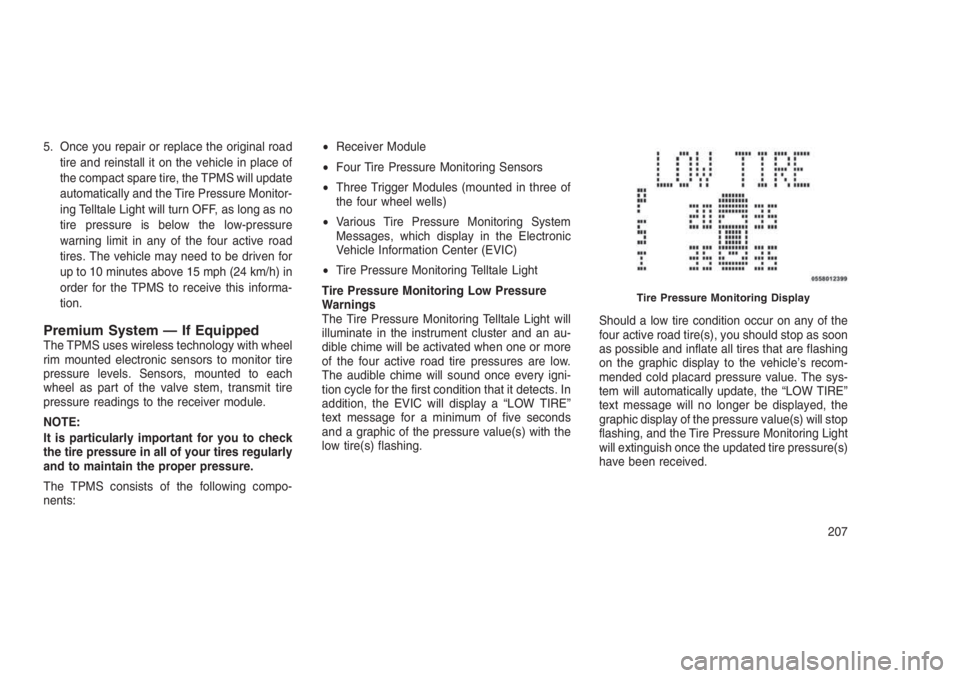
5. Once you repair or replace the original road
tire and reinstall it on the vehicle in place of
the compact spare tire, the TPMS will update
automatically and the Tire Pressure Monitor-
ing Telltale Light will turn OFF, as long as no
tire pressure is below the low-pressure
warning limit in any of the four active road
tires. The vehicle may need to be driven for
up to 10 minutes above 15 mph (24 km/h) in
order for the TPMS to receive this informa-
tion.
Premium System — If EquippedThe TPMS uses wireless technology with wheel
rim mounted electronic sensors to monitor tire
pressure levels. Sensors, mounted to each
wheel as part of the valve stem, transmit tire
pressure readings to the receiver module.
NOTE:
It is particularly important for you to check
the tire pressure in all of your tires regularly
and to maintain the proper pressure.
The TPMS consists of the following compo-
nents:•Receiver Module
•Four Tire Pressure Monitoring Sensors
•Three Trigger Modules (mounted in three of
the four wheel wells)
•Various Tire Pressure Monitoring System
Messages, which display in the Electronic
Vehicle Information Center (EVIC)
•Tire Pressure Monitoring Telltale Light
Tire Pressure Monitoring Low Pressure
Warnings
The Tire Pressure Monitoring Telltale Light will
illuminate in the instrument cluster and an au-
dible chime will be activated when one or more
of the four active road tire pressures are low.
The audible chime will sound once every igni-
tion cycle for the first condition that it detects. In
addition, the EVIC will display a “LOW TIRE”
text message for a minimum of five seconds
and a graphic of the pressure value(s) with the
low tire(s) flashing.Should a low tire condition occur on any of the
four active road tire(s), you should stop as soon
as possible and inflate all tires that are flashing
on the graphic display to the vehicle’s recom-
mended cold placard pressure value. The sys-
tem will automatically update, the “LOW TIRE”
text message will no longer be displayed, the
graphic display of the pressure value(s) will stop
flashing, and the Tire Pressure Monitoring Light
will extinguish once the updated tire pressure(s)
have been received.
Tire Pressure Monitoring Display
207
Page 212 of 332
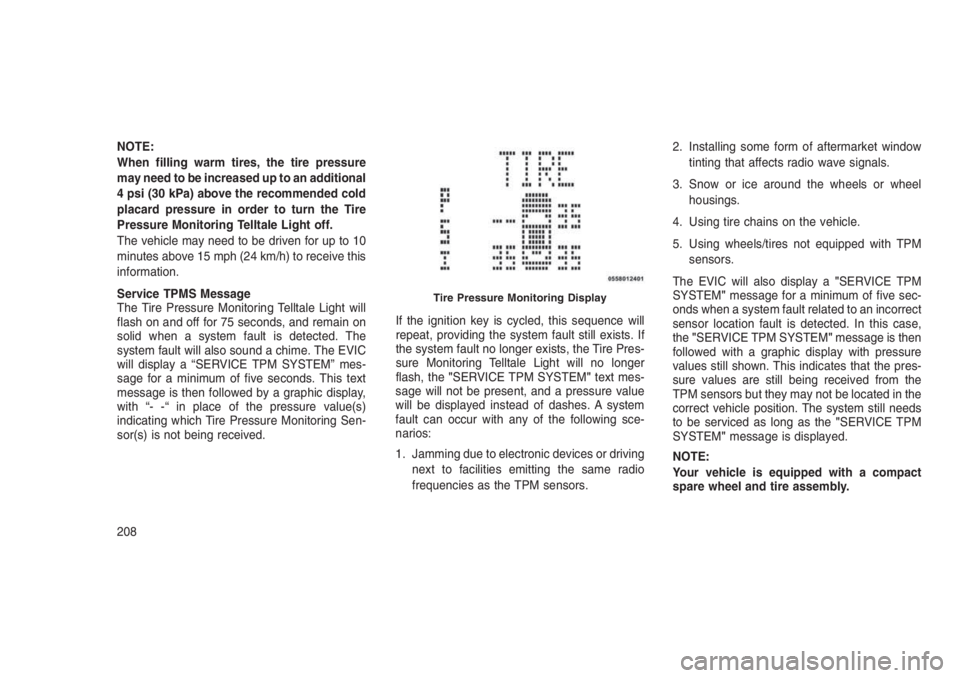
NOTE:
When filling warm tires, the tire pressure
may need to be increased up to an additional
4 psi (30 kPa) above the recommended cold
placard pressure in order to turn the Tire
Pressure Monitoring Telltale Light off.
The vehicle may need to be driven for up to 10
minutes above 15 mph (24 km/h) to receive this
information.
Service TPMS Message
The Tire Pressure Monitoring Telltale Light will
flash on and off for 75 seconds, and remain on
solid when a system fault is detected. The
system fault will also sound a chime. The EVIC
will display a “SERVICE TPM SYSTEM” mes-
sage for a minimum of five seconds. This text
message is then followed by a graphic display,
with “- -“ in place of the pressure value(s)
indicating which Tire Pressure Monitoring Sen-
sor(s) is not being received.If the ignition key is cycled, this sequence will
repeat, providing the system fault still exists. If
the system fault no longer exists, the Tire Pres-
sure Monitoring Telltale Light will no longer
flash, the"SERVICE TPM SYSTEM"text mes-
sage will not be present, and a pressure value
will be displayed instead of dashes. A system
fault can occur with any of the following sce-
narios:
1. Jamming due to electronic devices or driving
next to facilities emitting the same radio
frequencies as the TPM sensors.2. Installing some form of aftermarket window
tinting that affects radio wave signals.
3. Snow or ice around the wheels or wheel
housings.
4. Using tire chains on the vehicle.
5. Using wheels/tires not equipped with TPM
sensors.
The EVIC will also display a"SERVICE TPM
SYSTEM"message for a minimum of five sec-
onds when a system fault related to an incorrect
sensor location fault is detected. In this case,
the"SERVICE TPM SYSTEM"message is then
followed with a graphic display with pressure
values still shown. This indicates that the pres-
sure values are still being received from the
TPM sensors but they may not be located in the
correct vehicle position. The system still needs
to be serviced as long as the"SERVICE TPM
SYSTEM"message is displayed.
NOTE:
Your vehicle is equipped with a compact
spare wheel and tire assembly.
Tire Pressure Monitoring Display
208
Page 213 of 332
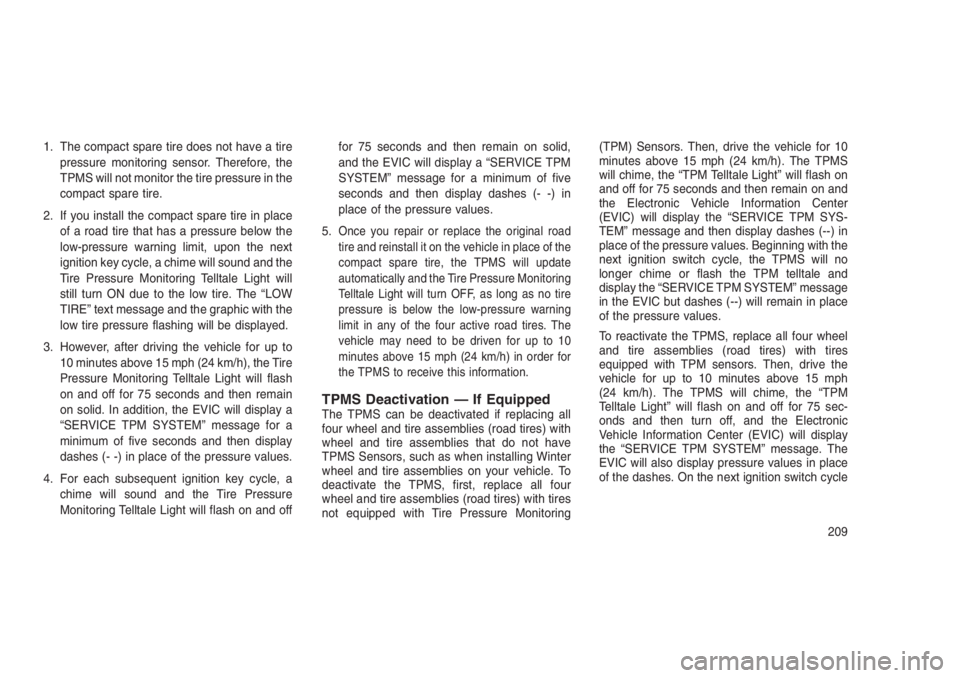
1. The compact spare tire does not have a tire
pressure monitoring sensor. Therefore, the
TPMS will not monitor the tire pressure in the
compact spare tire.
2. If you install the compact spare tire in place
of a road tire that has a pressure below the
low-pressure warning limit, upon the next
ignition key cycle, a chime will sound and the
Tire Pressure Monitoring Telltale Light will
still turn ON due to the low tire. The “LOW
TIRE” text message and the graphic with the
low tire pressure flashing will be displayed.
3. However, after driving the vehicle for up to
10 minutes above 15 mph (24 km/h), the Tire
Pressure Monitoring Telltale Light will flash
on and off for 75 seconds and then remain
on solid. In addition, the EVIC will display a
“SERVICE TPM SYSTEM” message for a
minimum of five seconds and then display
dashes (- -) in place of the pressure values.
4. For each subsequent ignition key cycle, a
chime will sound and the Tire Pressure
Monitoring Telltale Light will flash on and offfor 75 seconds and then remain on solid,
and the EVIC will display a “SERVICE TPM
SYSTEM” message for a minimum of five
seconds and then display dashes (- -) in
place of the pressure values.
5.
Once you repair or replace the original road
tire and reinstall it on the vehicle in place of the
compact spare tire, the TPMS will update
automatically and the Tire Pressure Monitoring
Telltale Light will turn OFF, as long as no tire
pressure is below the low-pressure warning
limit in any of the four active road tires. The
vehicle may need to be driven for up to 10
minutes above 15 mph (24 km/h) in order for
the TPMS to receive this information.
TPMS Deactivation — If EquippedThe TPMS can be deactivated if replacing all
four wheel and tire assemblies (road tires) with
wheel and tire assemblies that do not have
TPMS Sensors, such as when installing Winter
wheel and tire assemblies on your vehicle. To
deactivate the TPMS, first, replace all four
wheel and tire assemblies (road tires) with tires
not equipped with Tire Pressure Monitoring(TPM) Sensors. Then, drive the vehicle for 10
minutes above 15 mph (24 km/h). The TPMS
will chime, the “TPM Telltale Light” will flash on
and off for 75 seconds and then remain on and
the Electronic Vehicle Information Center
(EVIC) will display the “SERVICE TPM SYS-
TEM” message and then display dashes (--) in
place of the pressure values. Beginning with the
next ignition switch cycle, the TPMS will no
longer chime or flash the TPM telltale and
display the “SERVICE TPM SYSTEM” message
in the EVIC but dashes (--) will remain in place
of the pressure values.
To reactivate the TPMS, replace all four wheel
and tire assemblies (road tires) with tires
equipped with TPM sensors. Then, drive the
vehicle for up to 10 minutes above 15 mph
(24 km/h). The TPMS will chime, the “TPM
Telltale Light” will flash on and off for 75 sec-
onds and then turn off, and the Electronic
Vehicle Information Center (EVIC) will display
the “SERVICE TPM SYSTEM” message. The
EVIC will also display pressure values in place
of the dashes. On the next ignition switch cycle
209
Page 214 of 332
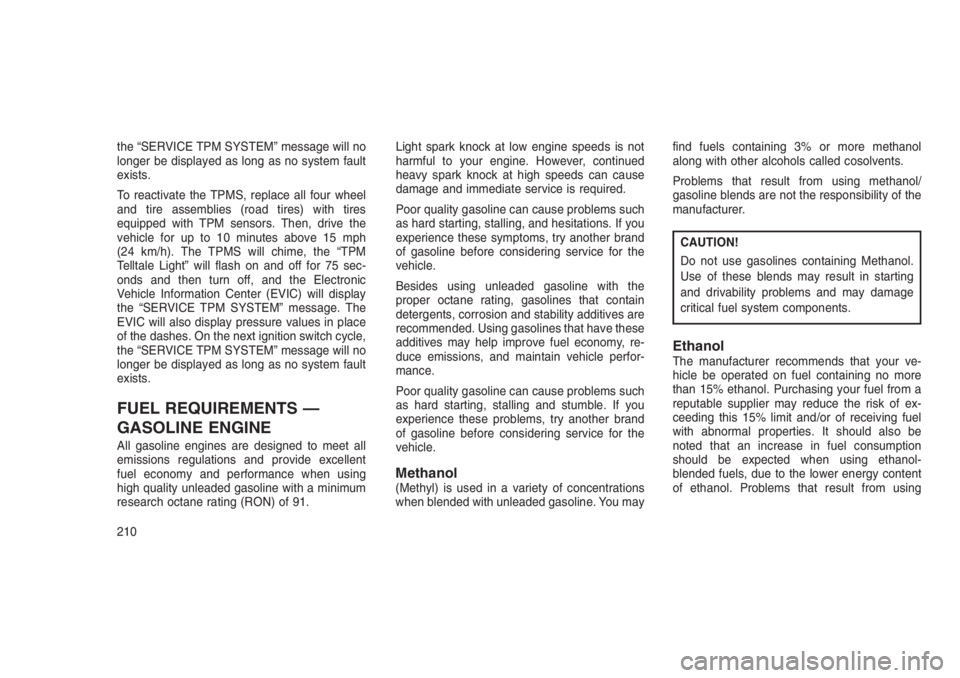
the “SERVICE TPM SYSTEM” message will no
longer be displayed as long as no system fault
exists.
To reactivate the TPMS, replace all four wheel
and tire assemblies (road tires) with tires
equipped with TPM sensors. Then, drive the
vehicle for up to 10 minutes above 15 mph
(24 km/h). The TPMS will chime, the “TPM
Telltale Light” will flash on and off for 75 sec-
onds and then turn off, and the Electronic
Vehicle Information Center (EVIC) will display
the “SERVICE TPM SYSTEM” message. The
EVIC will also display pressure values in place
of the dashes. On the next ignition switch cycle,
the “SERVICE TPM SYSTEM” message will no
longer be displayed as long as no system fault
exists.
FUEL REQUIREMENTS —
GASOLINE ENGINE
All gasoline engines are designed to meet all
emissions regulations and provide excellent
fuel economy and performance when using
high quality unleaded gasoline with a minimum
research octane rating (RON) of 91.Light spark knock at low engine speeds is not
harmful to your engine. However, continued
heavy spark knock at high speeds can cause
damage and immediate service is required.
Poor quality gasoline can cause problems such
as hard starting, stalling, and hesitations. If you
experience these symptoms, try another brand
of gasoline before considering service for the
vehicle.
Besides using unleaded gasoline with the
proper octane rating, gasolines that contain
detergents, corrosion and stability additives are
recommended. Using gasolines that have these
additives may help improve fuel economy, re-
duce emissions, and maintain vehicle perfor-
mance.
Poor quality gasoline can cause problems such
as hard starting, stalling and stumble. If you
experience these problems, try another brand
of gasoline before considering service for the
vehicle.
Methanol(Methyl) is used in a variety of concentrations
when blended with unleaded gasoline. You mayfind fuels containing 3% or more methanol
along with other alcohols called cosolvents.
Problems that result from using methanol/
gasoline blends are not the responsibility of the
manufacturer.
CAUTION!
Do not use gasolines containing Methanol.
Use of these blends may result in starting
and drivability problems and may damage
critical fuel system components.
EthanolThe manufacturer recommends that your ve-
hicle be operated on fuel containing no more
than 15% ethanol. Purchasing your fuel from a
reputable supplier may reduce the risk of ex-
ceeding this 15% limit and/or of receiving fuel
with abnormal properties. It should also be
noted that an increase in fuel consumption
should be expected when using ethanol-
blended fuels, due to the lower energy content
of ethanol. Problems that result from using
210
Page 215 of 332
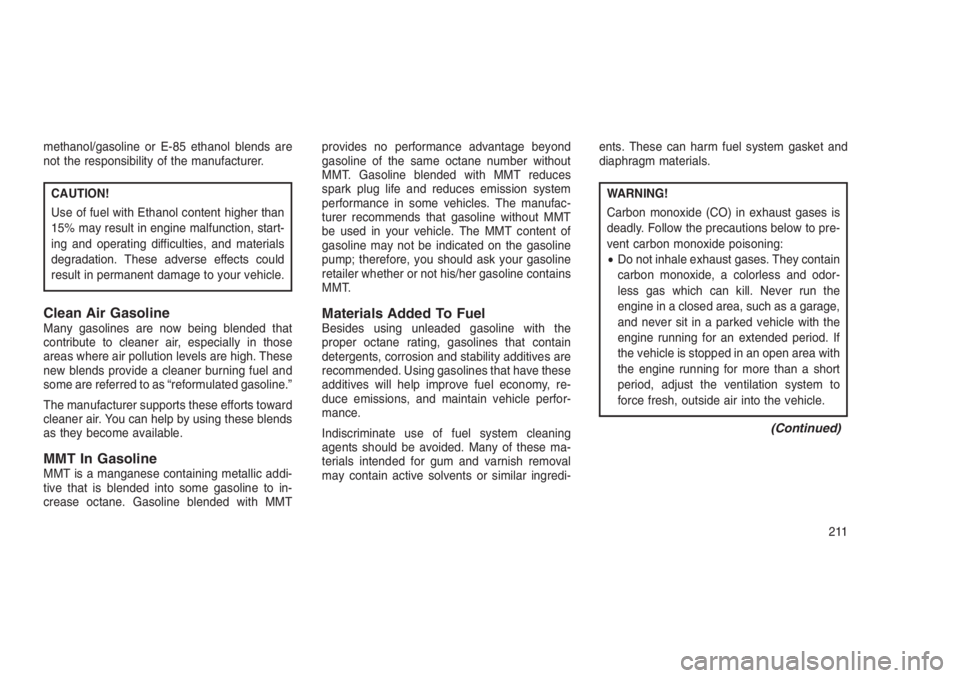
methanol/gasoline or E-85 ethanol blends are
not the responsibility of the manufacturer.
CAUTION!
Use of fuel with Ethanol content higher than
15% may result in engine malfunction, start-
ing and operating difficulties, and materials
degradation. These adverse effects could
result in permanent damage to your vehicle.
Clean Air GasolineMany gasolines are now being blended that
contribute to cleaner air, especially in those
areas where air pollution levels are high. These
new blends provide a cleaner burning fuel and
some are referred to as “reformulated gasoline.”
The manufacturer supports these efforts toward
cleaner air. You can help by using these blends
as they become available.
MMT In GasolineMMT is a manganese containing metallic addi-
tive that is blended into some gasoline to in-
crease octane. Gasoline blended with MMTprovides no performance advantage beyond
gasoline of the same octane number without
MMT. Gasoline blended with MMT reduces
spark plug life and reduces emission system
performance in some vehicles. The manufac-
turer recommends that gasoline without MMT
be used in your vehicle. The MMT content of
gasoline may not be indicated on the gasoline
pump; therefore, you should ask your gasoline
retailer whether or not his/her gasoline contains
MMT.
Materials Added To FuelBesides using unleaded gasoline with the
proper octane rating, gasolines that contain
detergents, corrosion and stability additives are
recommended. Using gasolines that have these
additives will help improve fuel economy, re-
duce emissions, and maintain vehicle perfor-
mance.
Indiscriminate use of fuel system cleaning
agents should be avoided. Many of these ma-
terials intended for gum and varnish removal
may contain active solvents or similar ingredi-ents. These can harm fuel system gasket and
diaphragm materials.
WARNING!
Carbon monoxide (CO) in exhaust gases is
deadly. Follow the precautions below to pre-
vent carbon monoxide poisoning:
•Do not inhale exhaust gases. They contain
carbon monoxide, a colorless and odor-
less gas which can kill. Never run the
engine in a closed area, such as a garage,
and never sit in a parked vehicle with the
engine running for an extended period. If
the vehicle is stopped in an open area with
the engine running for more than a short
period, adjust the ventilation system to
force fresh, outside air into the vehicle.
(Continued)
211
Page 216 of 332
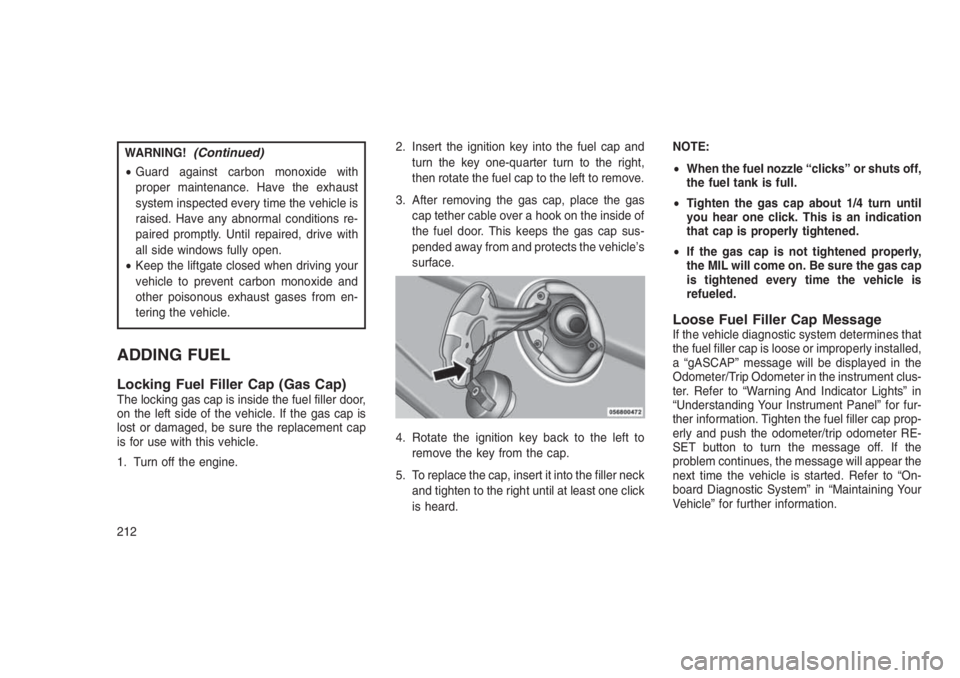
WARNING!(Continued)
•Guard against carbon monoxide with
proper maintenance. Have the exhaust
system inspected every time the vehicle is
raised. Have any abnormal conditions re-
paired promptly. Until repaired, drive with
all side windows fully open.
•Keep the liftgate closed when driving your
vehicle to prevent carbon monoxide and
other poisonous exhaust gases from en-
tering the vehicle.
ADDING FUEL
Locking Fuel Filler Cap (Gas Cap)The locking gas cap is inside the fuel filler door,
on the left side of the vehicle. If the gas cap is
lost or damaged, be sure the replacement cap
is for use with this vehicle.
1. Turn off the engine.2. Insert the ignition key into the fuel cap and
turn the key one-quarter turn to the right,
then rotate the fuel cap to the left to remove.
3. After removing the gas cap, place the gas
cap tether cable over a hook on the inside of
the fuel door. This keeps the gas cap sus-
pended away from and protects the vehicle’s
surface.
4. Rotate the ignition key back to the left to
remove the key from the cap.
5. To replace the cap, insert it into the filler neck
and tighten to the right until at least one click
is heard.NOTE:
•When the fuel nozzle “clicks” or shuts off,
the fuel tank is full.
•Tighten the gas cap about 1/4 turn until
you hear one click. This is an indication
that cap is properly tightened.
•If the gas cap is not tightened properly,
the MIL will come on. Be sure the gas cap
is tightened every time the vehicle is
refueled.
Loose Fuel Filler Cap MessageIf the vehicle diagnostic system determines that
the fuel filler cap is loose or improperly installed,
a “gASCAP” message will be displayed in the
Odometer/Trip Odometer in the instrument clus-
ter. Refer to “Warning And Indicator Lights” in
“Understanding Your Instrument Panel” for fur-
ther information. Tighten the fuel filler cap prop-
erly and push the odometer/trip odometer RE-
SET button to turn the message off. If the
problem continues, the message will appear the
next time the vehicle is started. Refer to “On-
board Diagnostic System” in “Maintaining Your
Vehicle” for further information.
212
Page 217 of 332
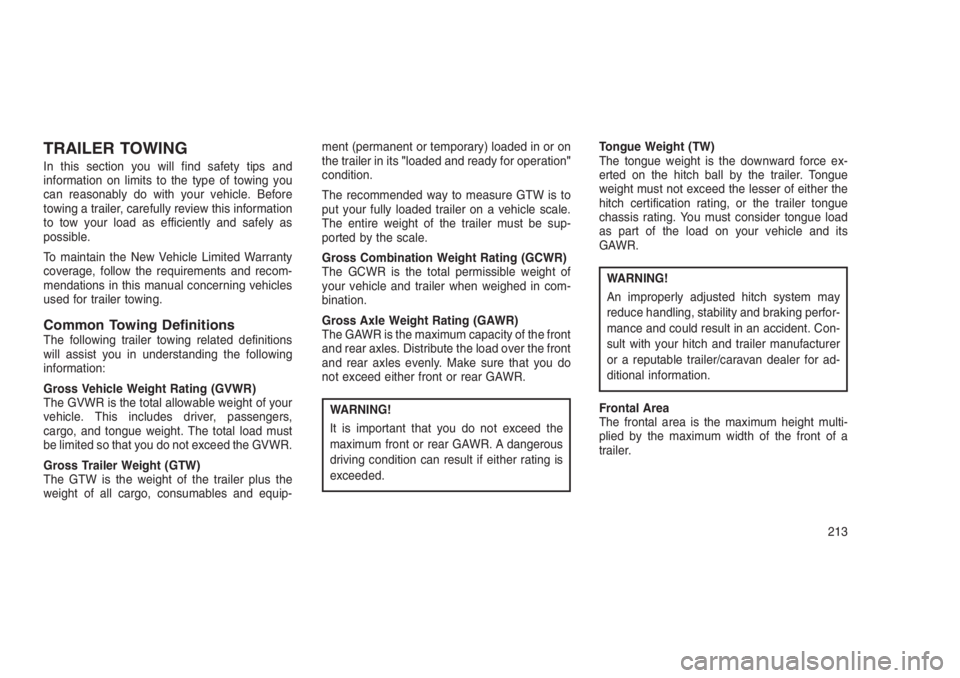
TRAILER TOWING
In this section you will find safety tips and
information on limits to the type of towing you
can reasonably do with your vehicle. Before
towing a trailer, carefully review this information
to tow your load as efficiently and safely as
possible.
To maintain the New Vehicle Limited Warranty
coverage, follow the requirements and recom-
mendations in this manual concerning vehicles
used for trailer towing.
Common Towing DefinitionsThe following trailer towing related definitions
will assist you in understanding the following
information:
Gross Vehicle Weight Rating (GVWR)
The GVWR is the total allowable weight of your
vehicle. This includes driver, passengers,
cargo, and tongue weight. The total load must
be limited so that you do not exceed the GVWR.
Gross Trailer Weight (GTW)
The GTW is the weight of the trailer plus the
weight of all cargo, consumables and equip-ment (permanent or temporary) loaded in or on
the trailer in its"loaded and ready for operation"
condition.
The recommended way to measure GTW is to
put your fully loaded trailer on a vehicle scale.
The entire weight of the trailer must be sup-
ported by the scale.
Gross Combination Weight Rating (GCWR)
The GCWR is the total permissible weight of
your vehicle and trailer when weighed in com-
bination.
Gross Axle Weight Rating (GAWR)
The GAWR is the maximum capacity of the front
and rear axles. Distribute the load over the front
and rear axles evenly. Make sure that you do
not exceed either front or rear GAWR.
WARNING!
It is important that you do not exceed the
maximum front or rear GAWR. A dangerous
driving condition can result if either rating is
exceeded.Tongue Weight (TW)
The tongue weight is the downward force ex-
erted on the hitch ball by the trailer. Tongue
weight must not exceed the lesser of either the
hitch certification rating, or the trailer tongue
chassis rating. You must consider tongue load
as part of the load on your vehicle and its
GAWR.
WARNING!
An improperly adjusted hitch system may
reduce handling, stability and braking perfor-
mance and could result in an accident. Con-
sult with your hitch and trailer manufacturer
or a reputable trailer/caravan dealer for ad-
ditional information.
Frontal Area
The frontal area is the maximum height multi-
plied by the maximum width of the front of a
trailer.
213
Page 218 of 332
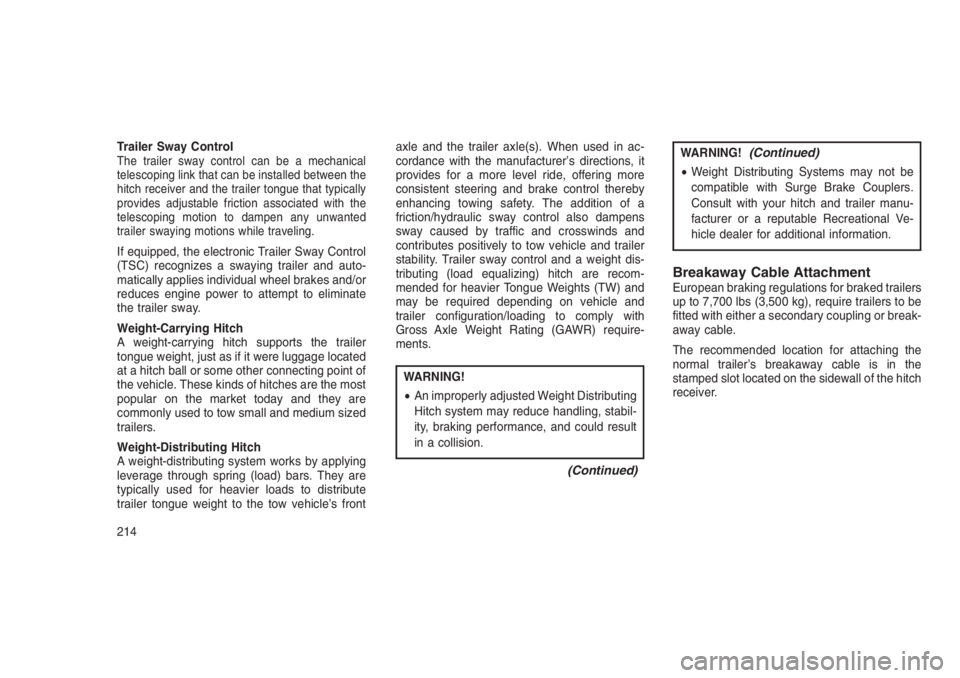
Trailer Sway ControlThe trailer sway control can be a mechanical
telescoping link that can be installed between the
hitch receiver and the trailer tongue that typically
provides adjustable friction associated with the
telescoping motion to dampen any unwanted
trailer swaying motions while traveling.
If equipped, the electronic Trailer Sway Control
(TSC) recognizes a swaying trailer and auto-
matically applies individual wheel brakes and/or
reduces engine power to attempt to eliminate
the trailer sway.
Weight-Carrying Hitch
A weight-carrying hitch supports the trailer
tongue weight, just as if it were luggage located
at a hitch ball or some other connecting point of
the vehicle. These kinds of hitches are the most
popular on the market today and they are
commonly used to tow small and medium sized
trailers.
Weight-Distributing Hitch
A weight-distributing system works by applying
leverage through spring (load) bars. They are
typically used for heavier loads to distribute
trailer tongue weight to the tow vehicle’s frontaxle and the trailer axle(s). When used in ac-
cordance with the manufacturer’s directions, it
provides for a more level ride, offering more
consistent steering and brake control thereby
enhancing towing safety. The addition of a
friction/hydraulic sway control also dampens
sway caused by traffic and crosswinds and
contributes positively to tow vehicle and trailer
stability. Trailer sway control and a weight dis-
tributing (load equalizing) hitch are recom-
mended for heavier Tongue Weights (TW) and
may be required depending on vehicle and
trailer configuration/loading to comply with
Gross Axle Weight Rating (GAWR) require-
ments.
WARNING!
•An improperly adjusted Weight Distributing
Hitch system may reduce handling, stabil-
ity, braking performance, and could result
in a collision.
(Continued)
WARNING!(Continued)
•Weight Distributing Systems may not be
compatible with Surge Brake Couplers.
Consult with your hitch and trailer manu-
facturer or a reputable Recreational Ve-
hicle dealer for additional information.
Breakaway Cable AttachmentEuropean braking regulations for braked trailers
up to 7,700 lbs (3,500 kg), require trailers to be
fitted with either a secondary coupling or break-
away cable.
The recommended location for attaching the
normal trailer’s breakaway cable is in the
stamped slot located on the sidewall of the hitch
receiver.
214
Page 219 of 332
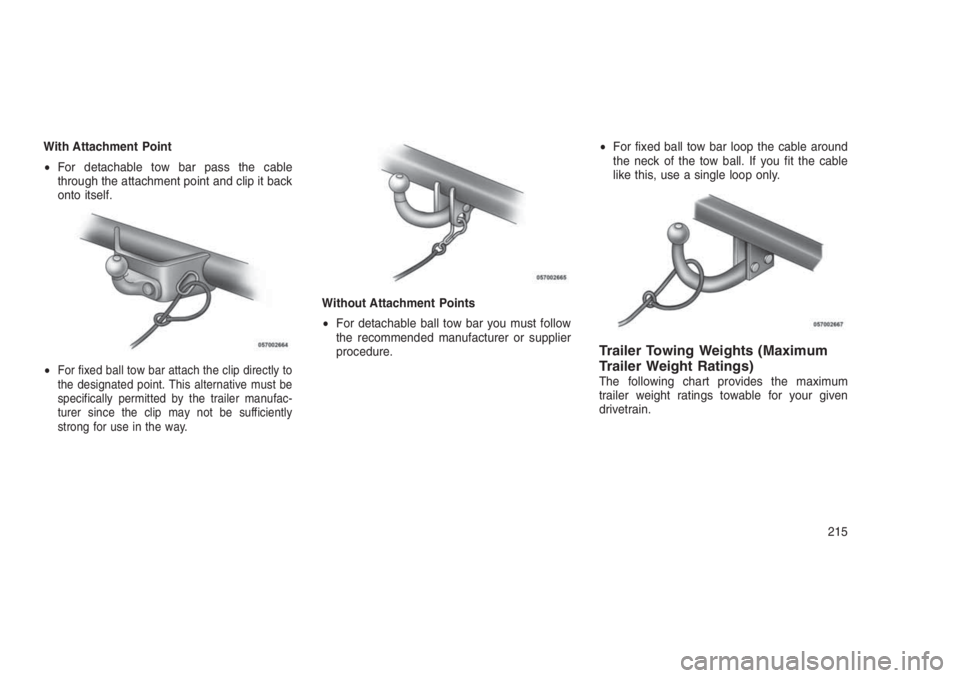
With Attachment Point
•For detachable tow bar pass the cable
through the attachment point and clip it back
onto itself.
•
For fixed ball tow bar attach the clip directly to
the designated point. This alternative must be
specifically permitted by the trailer manufac-
turer since the clip may not be sufficiently
strong for use in the way.
Without Attachment Points
•For detachable ball tow bar you must follow
the recommended manufacturer or supplier
procedure.•For fixed ball tow bar loop the cable around
the neck of the tow ball. If you fit the cable
like this, use a single loop only.
Trailer Towing Weights (Maximum
Trailer Weight Ratings)
The following chart provides the maximum
trailer weight ratings towable for your given
drivetrain.
215
Page 220 of 332
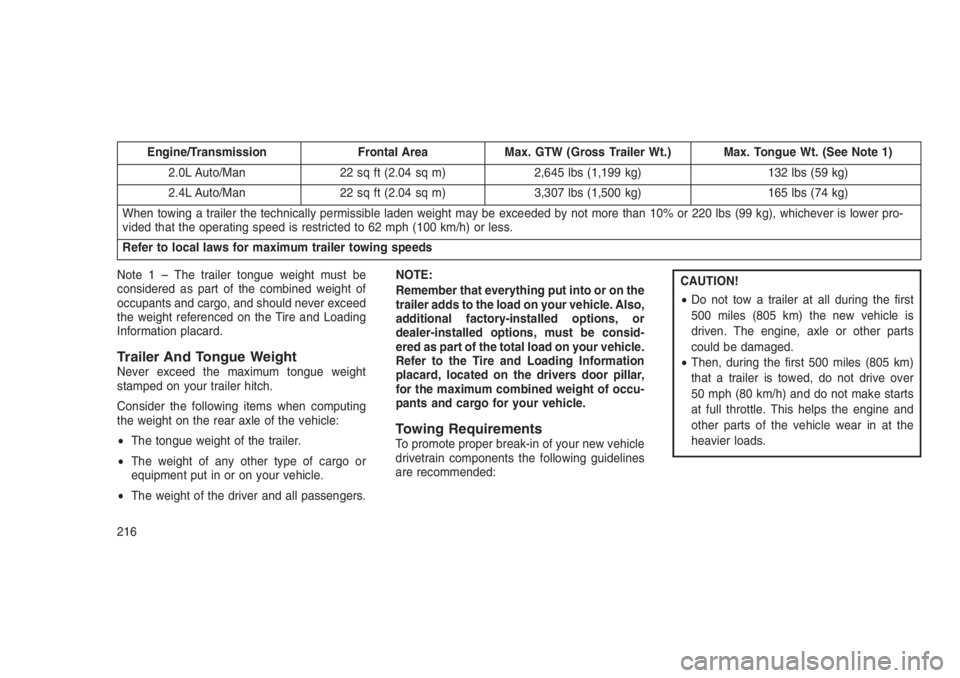
Engine/Transmission Frontal Area Max. GTW (Gross Trailer Wt.) Max. Tongue Wt. (See Note 1)
2.0L Auto/Man 22 sq ft (2.04 sq m) 2,645 lbs (1,199 kg) 132 lbs (59 kg)
2.4L Auto/Man 22 sq ft (2.04 sq m) 3,307 lbs (1,500 kg) 165 lbs (74 kg)
When towing a trailer the technically permissible laden weight may be exceeded by not more than 10% or 220 lbs (99 kg), whichever is lower pro-
vided that the operating speed is restricted to 62 mph (100 km/h) or less.
Refer to local laws for maximum trailer towing speeds
Note 1 – The trailer tongue weight must be
considered as part of the combined weight of
occupants and cargo, and should never exceed
the weight referenced on the Tire and Loading
Information placard.
Trailer And Tongue WeightNever exceed the maximum tongue weight
stamped on your trailer hitch.
Consider the following items when computing
the weight on the rear axle of the vehicle:
•The tongue weight of the trailer.
•The weight of any other type of cargo or
equipment put in or on your vehicle.
•The weight of the driver and all passengers.NOTE:
Remember that everything put into or on the
trailer adds to the load on your vehicle. Also,
additional factory-installed options, or
dealer-installed options, must be consid-
ered as part of the total load on your vehicle.
Refer to the Tire and Loading Information
placard, located on the drivers door pillar,
for the maximum combined weight of occu-
pants and cargo for your vehicle.
Towing RequirementsTo promote proper break-in of your new vehicle
drivetrain components the following guidelines
are recommended:
CAUTION!
•Do not tow a trailer at all during the first
500 miles (805 km) the new vehicle is
driven. The engine, axle or other parts
could be damaged.
•Then, during the first 500 miles (805 km)
that a trailer is towed, do not drive over
50 mph (80 km/h) and do not make starts
at full throttle. This helps the engine and
other parts of the vehicle wear in at the
heavier loads.
216